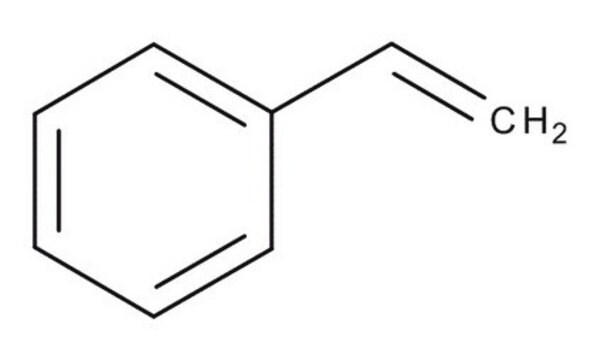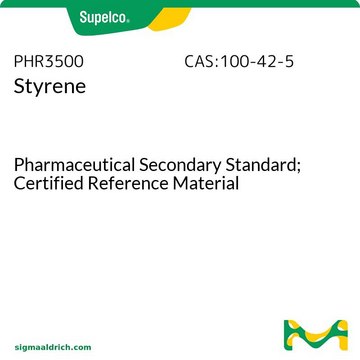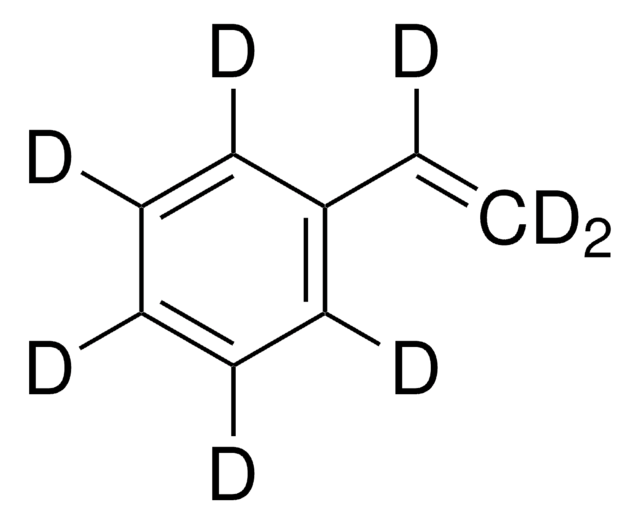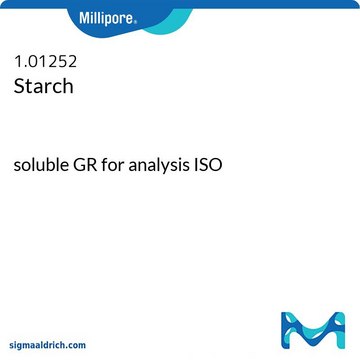47745-U
Styrene
analytical standard
Sinonimo/i:
Phenylethylene, Vinylbenzene
About This Item
Prodotti consigliati
Grado
analytical standard
Densità del vapore
3.6 (vs air)
Tensione di vapore
12.4 mmHg ( 37.7 °C)
4.3 mmHg ( 15 °C)
CdA
current certificate can be downloaded
Temp. autoaccensione
914 °F
Limite di esplosione
6.1 %
Confezionamento
ampule of 1000 mg
tecniche
HPLC: suitable
gas chromatography (GC): suitable
Indice di rifrazione
n20/D 1.546 (lit.)
P. ebollizione
145-146 °C (lit.)
Punto di fusione
−31 °C (lit.)
Densità
0.906 g/mL at 25 °C
applicazioni
environmental
Formato
neat
Temperatura di conservazione
2-8°C
Stringa SMILE
C=Cc1ccccc1
InChI
1S/C8H8/c1-2-8-6-4-3-5-7-8/h2-7H,1H2
PPBRXRYQALVLMV-UHFFFAOYSA-N
Cerchi prodotti simili? Visita Guida al confronto tra prodotti
Descrizione generale
Applicazioni
Altre note
Avvertenze
Danger
Indicazioni di pericolo
Consigli di prudenza
Classi di pericolo
Acute Tox. 4 Inhalation - Aquatic Chronic 3 - Asp. Tox. 1 - Eye Irrit. 2 - Flam. Liq. 3 - Repr. 2 - Skin Irrit. 2 - STOT RE 1 Inhalation - STOT SE 3
Organi bersaglio
hearing organs, Respiratory system
Codice della classe di stoccaggio
3 - Flammable liquids
Classe di pericolosità dell'acqua (WGK)
WGK 2
Punto d’infiammabilità (°F)
89.6 °F - closed cup
Punto d’infiammabilità (°C)
32.0 °C - closed cup
Dispositivi di protezione individuale
Eyeshields, Faceshields, Gloves, type ABEK (EN14387) respirator filter
Scegli una delle versioni più recenti:
Possiedi già questo prodotto?
I documenti relativi ai prodotti acquistati recentemente sono disponibili nell’Archivio dei documenti.
Protocolli
GC Analysis of Xylene Isomers on SLB®-IL60
US EPA Method TO-17: GC Analysis of Volatiles on VOCOL® after Collection/Desorption using Air Toxics Tube
US EPA Method 8260: GC Analysis of Volatiles on SPB®-624 after Purge & Trap using "K" Trap, Fast GC Analysis
Il team dei nostri ricercatori vanta grande esperienza in tutte le aree della ricerca quali Life Science, scienza dei materiali, sintesi chimica, cromatografia, discipline analitiche, ecc..
Contatta l'Assistenza Tecnica.









